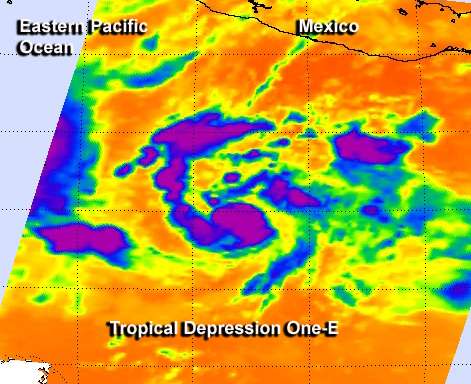NASA sees first Eastern Pacific tropical depression to open season

The Hurricane Season of the Eastern Pacific Ocean officially begins today, May 15 and the first tropical depression of the season formed. Tropical Depression One-E was seen by NASA's Aqua satellite while it was developing.
The first tropical depression formed around 11 a.m. EDT on May 15. NASA's Aqua satellite flew over Tropical Depression 1-E (TD1E) at 08:23 UTC (4:23 a.m. EDT) and the Atmospheric Infrared Sounder (AIRS) instrument captured an infrared image of the storm. AIRS data showed bands of thunderstorms wrapping into the low-level center from the west, as well as a fragmented band of thunderstorms east of center. Cloud top temperatures of the thunderstorms were as cold as -63 Fahrenheit (-52 Celsius) indicating strong thunderstorms with heavy rainfall potential.
At 11 a.m. EDT on May 15, TD1E had maximum sustained winds near 35 mph (55 kph). It was located far from land, about 650 miles (1,045 km) south-southwest of Acapulco, Mexico, near 9.2 north latitude and 103.6 west longitude. TD1E was moving to the west at 12 mph (19 kph) and had a minimum central pressure near 1006 millibars. There are no coastal warnings or watches in effect.
The National Hurricane Center noted that TD1E will be moving through warm waters over the next couple of days, which will likely strengthen it into Tropical Storm Alvin.
Provided by NASA's Goddard Space Flight Center




















